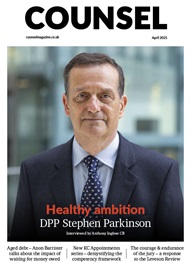*/
Public Access Bar Association
Public access now accounts for 12% of the Bar’s income; in 2009 the figure was just 2%; Five QCs, one a recent convert to ‘the Dark Side’ of judicial office gave personal views of public access.
There was a distinct family bias to this PABA session, which was none the worse for that. In fact as a civil practitioner, whose public access work is far more symbiotic with the solicitors’ profession, with clients often looking for initial advice and referral to a suitable solicitor, it was interesting to learn that in the family field, the Bar is far more often either in direct competition with solicitors or filling the void left by legal aid.
In the field of ancillary relief, the Bar can offer a far more cost-effective solution in big money cases; a telling example was given by Susan Jacklin QC who revealed that a direct access client had told her he had been given more substantive advice in their first four-hour conference than he had previously received after spending £¾million on three ‘blue chip’ solicitors’ firms. Thorny issues, such as writing correspondence and avoiding stepping over the sometimes-thin boundary that in practice can exist between permitted public access work and conducting litigation, was also discussed (although 6,000 barristers have completed training and registered for public access work only 220 have gone on to obtain a the qualification to conduct litigation). As a family judge, Robin Tolson QC echoed Sir Henry Brooke’s comments earlier in the day about the impossibility of maintaining equality of arms when one unrepresented party appears against another who is represented and the relief he feels when a previously unrepresented party has, through public access, managed to secure representation.
Public access now accounts for 12% of the Bar’s income; in 2009 the figure was just 2%; Five QCs, one a recent convert to ‘the Dark Side’ of judicial office gave personal views of public access.
There was a distinct family bias to this PABA session, which was none the worse for that. In fact as a civil practitioner, whose public access work is far more symbiotic with the solicitors’ profession, with clients often looking for initial advice and referral to a suitable solicitor, it was interesting to learn that in the family field, the Bar is far more often either in direct competition with solicitors or filling the void left by legal aid.
In the field of ancillary relief, the Bar can offer a far more cost-effective solution in big money cases; a telling example was given by Susan Jacklin QC who revealed that a direct access client had told her he had been given more substantive advice in their first four-hour conference than he had previously received after spending £¾million on three ‘blue chip’ solicitors’ firms. Thorny issues, such as writing correspondence and avoiding stepping over the sometimes-thin boundary that in practice can exist between permitted public access work and conducting litigation, was also discussed (although 6,000 barristers have completed training and registered for public access work only 220 have gone on to obtain a the qualification to conduct litigation). As a family judge, Robin Tolson QC echoed Sir Henry Brooke’s comments earlier in the day about the impossibility of maintaining equality of arms when one unrepresented party appears against another who is represented and the relief he feels when a previously unrepresented party has, through public access, managed to secure representation.
Public Access Bar Association


Now is the time to tackle inappropriate behaviour at the Bar as well as extend our reach and collaboration with organisations and individuals at home and abroad
A comparison – Dan Monaghan, Head of DWF Chambers, invites two viewpoints
And if not, why not? asks Louise Crush of Westgate Wealth Management
Marie Law, Head of Toxicology at AlphaBiolabs, discusses the many benefits of oral fluid drug testing for child welfare and protection matters
To mark International Women’s Day, Louise Crush of Westgate Wealth Management looks at how financial planning can help bridge the gap
Casey Randall of AlphaBiolabs answers some of the most common questions regarding relationship DNA testing for court
Maria Scotland and Niamh Wilkie report from the Bar Council’s 2024 visit to the United Arab Emirates exploring practice development opportunities for the England and Wales family Bar
Marking Neurodiversity Week 2025, an anonymous barrister shares the revelations and emotions from a mid-career diagnosis with a view to encouraging others to find out more
Save for some high-flyers and those who can become commercial arbitrators, it is generally a question of all or nothing but that does not mean moving from hero to zero, says Andrew Hillier
Patrick Green KC talks about the landmark Post Office Group litigation and his driving principles for life and practice. Interview by Anthony Inglese CB
Desiree Artesi meets Malcolm Bishop KC, the Lord Chief Justice of Tonga, who talks about his new role in the South Pacific and reflects on his career